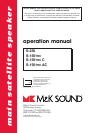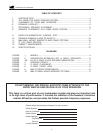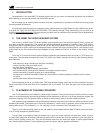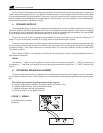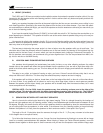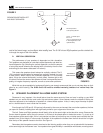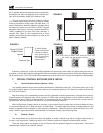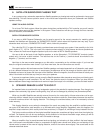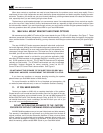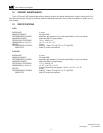
A. HEIGHT (OR ANGLE)
The S-250, and S-150 have a controlled vertical radiation pattern that makes the speaker’s location critical. It is very
important to aim the tweeters at the main listening position in order to achieve their very best sound quality and their flat-
test frequency response.
Ideally, your speakers' tweeters should be at the same height from the floor as your ears when you are sitting in your
main listening position. Specifically, this means the distance from the floor to the center tweeter. If you have the speak-
ers mounted above or below this height, you must tilt the speakers so that the tweeters are aimed at your ears when you
are in the main listening position.
If you have the special Angled Center (S-150AC), its front baffle has a built-in "tilt" that aims the sound either up or
down depending on orientation. This speaker is ideal for use as the center channel speaker sitting on top of a rear-pro-
jection television set.
You can start by aligning the speakers visually. Sit in your main listening position and look at the cabinets' tops and
bottoms. When their perspective is about the same relative to where you are sitting (about the same angle), you are at
least very close to the proper alignment.
The best way to determine the proper angle is to have a helper move the speakers while you sit and listen. You
should be able to hear the difference when the speakers are in the best location by listening for the brightest high fre-
quencies and for the best "focus" of sound, where you hear the sharpest sonic imaging of voices and instruments. To
aim the speakers more precisely, we recommend using a laser alignment tool. One can be purchased from M&K, sim-
ply visit our web site or call M&K directly.
B. LOCATION AWAY FROM REFLECTING SURFACES
Your speakers should generally be located away from walls, furniture, or any other reflecting surfaces. Any object
located close to the speaker will reflect the sound radiated from the speaker to your ear with a slight time delay com-
pared to the direct sound reaching your ear. This time delay will blur the sonic imaging and interfere with transient per-
formance.
The delay is very slight, so instead of hearing an echo, you hear a "blurred" sound with less clarity that is not as
sharp and distinct as it should be. This time delay also affects frequency response and sonic imaging.
If the speakers will be sitting on shelves, locate them on the front edge of the shelf, so there is no flat surface direct-
ly in front of them. If any speaker will sit close to a wall or any other large object, leave as much space as possible
between the speaker and the object. Ideally, your speakers will be located away from the nearest surface, but in most
rooms compromise will be necessary.
SPECIAL NOTE: For the S-250, locate the speakers away from reflecting surfaces near to the sides of the
speaker cabinet. This includes side walls, the sides of entertainment centers, other furniture, etc. The S-250 will
sound and perform at its optimum level when mounted to M&K speaker stands and located out in the room.
C. SEPARATION BETWEEN LEFT AND RIGHT SPEAKERS
Here is a formula for achieving the ideal left to right stereo imaging. Think of a triangle formed by the locations of
the left and right speakers and your listening position. Ideally, the subtended angle formed should be between 45 and
50 degrees. Roughly, this means that the left and right speakers should be separated by about the same distance that
you are sitting back from the speakers. In other words, if the distance from your listening position to the point directly
between the speakers is 10 feet, place the speakers so their centers are about 10 feet apart. See Figure 2.
The length of line A - B should be about the same as the length of line X - Y. (They may not seem to be the same
in this diagram due to an optical illusion).
Try to follow the formula as close as you can. You can fine tune the placement by listening to a source with an image
(such as a vocalist) centered between the speakers. When listening in stereo (no Center Channel speaker), move the
speakers closer together or farther apart in small increments until you hear the sharpest an most cohesive image, espe-
MAIN SATELLITE SPEAKER
5



